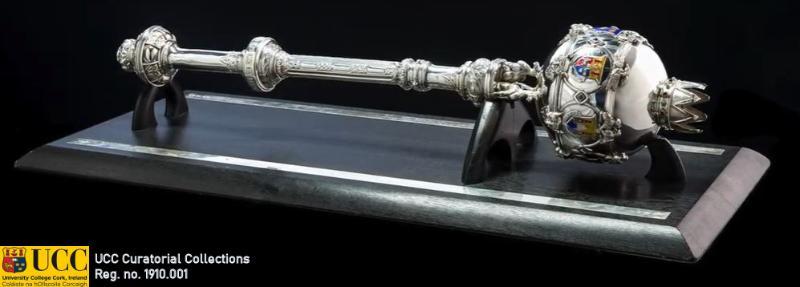University mace, William Egan & Sons, Cork

Silver, enamel, semi-precious stones; 1910, 102 cm in length, 23 cm in diameter.
Ref: UCCHS.1910.001 © University College Cork
Material: Sterling silver, enamel, semi-precious stones.
Maker: William Egan & Sons, 32-33 Patrick Street, Cork. This was made as their first item in modern times, reviving an industry that had died as a result of competition with English silver. The enamels were done by Archer (identified as James Archer by Vera Ryan).
Date: 1910. Two Dublin hallmarks, on the head and on the stem, as these are two separate parts that screw together just under the three canine figures supporting the head of the mace.
Provenance: Gift to UCC from friends and alumni of the University in 1910 [Cork Examiner, 27/10/1910, p.5]. In the introduction to Cork: Its Trade and Commerce: Official Handbook of the Cork Chamber of Commerce and Shipping (Guy & Company, Cork, 1919), by Sir Bertram Windle, he describes the commissioning of the UCC Mace.
Exhibited: 'Airgeadóir – 400 years of Cork Silver and Gold', exhibition held in Crawford Gallery of Art, curated by Conor O’Brien and John R. Bowen, 2005.
The historic mace of UCC is the symbol of the authority of the University to govern itself. The shape is derived from the medieval weapon of the same name, a metal version of a wooden club, which has come to be adopted as a symbol of authority and identity by civic and other public bodies, including universities. The mace was commissioned in 1910 apparently by Sir Bertram Windle, President of University College, Cork as a suitable symbol of UCC as part of the National University of Ireland (founded in 1908). The inscription on the stem records that it was a gift of the friends and alumni of UCC.
The mace is of beaten silver, decorated with surface and relief ornament, mounted 'jewels' and enamelled coats of arms. It consists of a hollow ball-shaped head surmounted by a spiked open crown, which is placed on the heads of three seated dog figures, which in turn are placed on the flat disc-shaped top of the mace stem. The stem is essentially a cylindrical tube with knops and an expanded end. The quality of the workmanship of design, construction and decoration is of the highest order.
The enamelled coats of arms are of Munster and the principal towns mentioned in the 1908 NUI Charter (Tralee, Limerick, Cashel, Waterford, Cork), along with the crest of UCC. The mace is marked with the normal marks of assay, in two places, indicating that it was submitted for assay in Dublin in at least two parts. The makers, Egan’s of Patrick Street (and workshop at Maylor Street) in Cork, made this as their first item. This means this is the first item of modern Cork silver, reviving an industry that had died as a result of the 1800 Act of Union that enabled the import of cheaper mass-produced English imports. Egan’s silver is highly sought-after today by collectors and connoisseurs.
Watch this short YouTube film about the mace narrated by the late Michael Holland, University Curator, in 2017.
Inscription: The stem of the mace is inscribed, in Latin: 'Me Socii et Alumni Pii Collegii Universitatis apud Corcagiam Almae Matri Suae Dono Dederunt A.D. MCMX. Bertramo Windle Praeside. Egan et Filii Argentarii Corcagienses me Fecerunt'.
In English this can be read as: "The pious friends and alumni of University College Cork gave me as a gift to their Alma Mater in [the year of Our Lord] 1910, in the Presidency of Bertram Windle. Egan and Sons, Silversmiths of Cork, made me."
The mace is made to speak of itself. This is typical of ancient inscriptions on various objects.
Notes: 'socii' literally means 'ally'. The list of subscribers published in the UCC Gazette in 1910 gives an idea of the status of those people who supported the cost of the mace. 'Pii' is translated with both socii and alumni. Its meaning in Classical Latin is not 'pious' but rather 'having due regard for parents and native land'. The pietas here is probably that due to the Alma Mater (lit. 'dear Mother').
© University College Cork 2020
